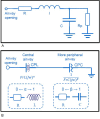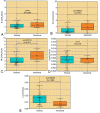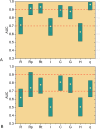Prediction of Abnormal Functional Performance in Chronic Obstructive Pulmonary Disease Using Respiratory Models: A Pilot Study
- PMID: 40873467
- PMCID: PMC12380091
- DOI: 10.2147/COPD.S524591
Prediction of Abnormal Functional Performance in Chronic Obstructive Pulmonary Disease Using Respiratory Models: A Pilot Study
Abstract
Introduction: The contribution of respiratory models to understanding and predicting functional capacity abnormalities in chronic obstructive pulmonary disease (COPD) has not yet been investigated.
Purpose: The aims of this study were: (1) To investigate the associations between the extended Resistance-Inertance-Compliance (eRIC) and the fractional-order (FrOr) models with changes in Glittre-ADL and handgrip tests and; (2) To evaluate the accuracy of these models in predicting abnormal functional capacity in COPD.
Patients and methods: The study was carried out in a group of 40 adults with COPD and a control group of 40 healthy individuals, both evaluated by respiratory oscillometry, spirometry, Glittre-ADL test and handgrip test. eRIC and fractional order models were also used to quantify biomechanical changes and obtain physiological information. The ability of model parameters to predict abnormal functional performance was evaluated by investigating the area under the receiver operating characteristic curve (AUC).
Results: Inverse relationships were observed between central airway resistance from the eRIC model and the handgrip test (p<0.005), while respiratory compliance (C) was directly related with handgrip strength test and inversely associated with the Glittre-ADL test time (p<0.05). The FrOr model showed direct associations among respiratory damping (G) and elastance with the Glittre-ADL test (p<0.02), while significant inverse relationships were observed with the handgrip test (p<0.05). Modeling parameters (peripheral resistance, total resistance and hysteresivity) achieved high prediction accuracy (AUC>0.90) in predicting non-normal functional capacity in COPD assessed by the Glittre-ADL test. Considering abnormal changes evaluated by the handgrip test as a reference, C (AUC=0.810) and G (AUC=0.786) obtained the highest predictive accuracies.
Conclusion: Parameters obtained from the eRIC and the fractional order models are associated with non-normal exercise performance in COPD and may help predict poor functional performance in these patients.
Keywords: COPD; Glittre-ADL; forced oscillation technique; handgrip test; respiratory oscillometry; respiratory system modeling.
© 2025 Ribeiro et al.
Conflict of interest statement
The authors declare that they have no competing interests in this work.
Figures








Similar articles
-
Respiratory Oscillometry and Functional Performance in Different COPD Phenotypes.Int J Chron Obstruct Pulmon Dis. 2024 Mar 6;19:667-682. doi: 10.2147/COPD.S446085. eCollection 2024. Int J Chron Obstruct Pulmon Dis. 2024. PMID: 38464561 Free PMC article.
-
Effects of a 12-week physiotherapist-supervised home-based rehabilitation program on the functional exercise capacity in people with systemic sclerosis.J Scleroderma Relat Disord. 2025 Jul 28:23971983251360912. doi: 10.1177/23971983251360912. Online ahead of print. J Scleroderma Relat Disord. 2025. PMID: 40746332 Free PMC article.
-
Comparison of oscillometry with lung function parameters between patients with stable bronchial asthma with airflow obstruction and chronic obstructive pulmonary disease.BMC Pulm Med. 2025 Jul 10;25(1):333. doi: 10.1186/s12890-025-03754-2. BMC Pulm Med. 2025. PMID: 40640734 Free PMC article.
-
Pulmonary rehabilitation for chronic obstructive pulmonary disease.Cochrane Database Syst Rev. 2015 Feb 23;2015(2):CD003793. doi: 10.1002/14651858.CD003793.pub3. Cochrane Database Syst Rev. 2015. PMID: 25705944 Free PMC article.
-
Self-management interventions for people with chronic obstructive pulmonary disease.Cochrane Database Syst Rev. 2022 Jan 10;1(1):CD002990. doi: 10.1002/14651858.CD002990.pub4. Cochrane Database Syst Rev. 2022. PMID: 35001366 Free PMC article.
References
-
- Khan MI, Khan M, Mannino DM. The new epidemiology of COPD. J COPD in the 21st Century Sheffield, European Respiratory Society. 2024;2024:63–80.
-
- The Global Strategy for the Diagnosis. Management and prevention of COPD, Global Initiative for Chronic Obstructive Lung Disease (GOLD). 2023. Available from: http://wwwgoldcopdorg. Accessed August 20, 2025.
-
- Karkhanis V, Joshi J. Spirometry in chronic obstructive lung disease (COPD). J Associat Phys India. 2012;60 Suppl:22–26. - PubMed
MeSH terms
LinkOut - more resources
Full Text Sources
Medical

